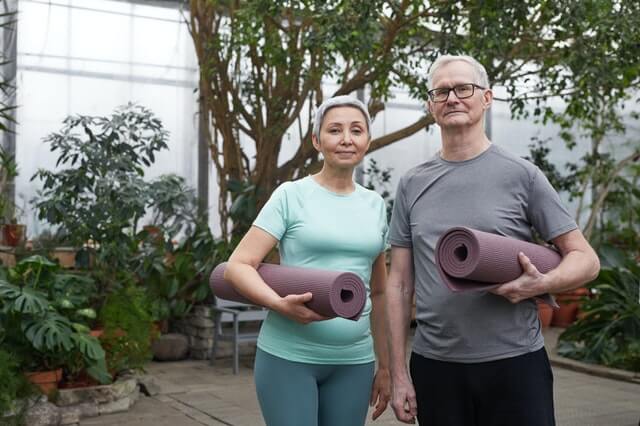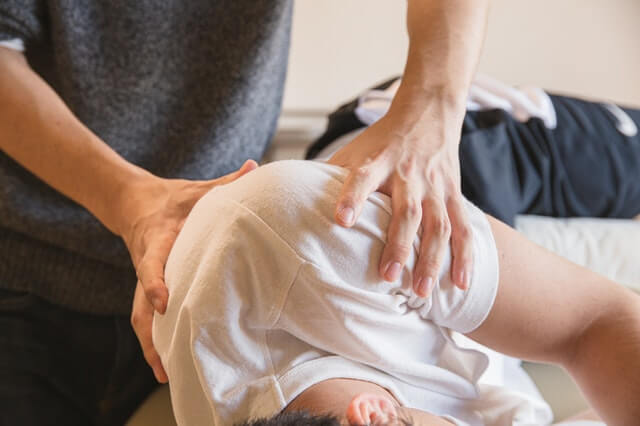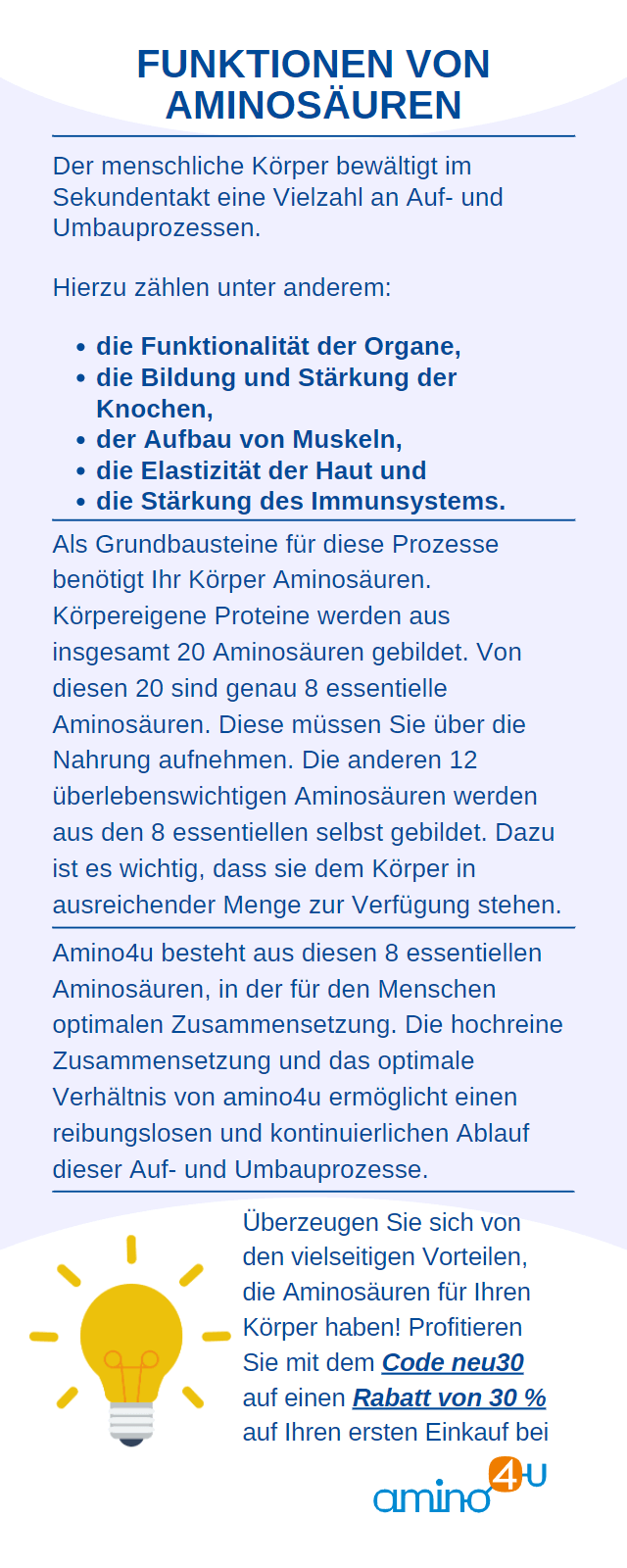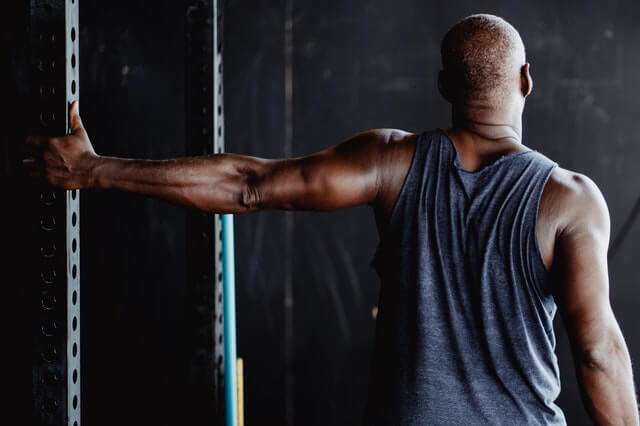Osteoarthritis shoulder strength training: More and more people are suffering from joint problems and osteoarthritis. Artificial joints, pain therapies with injections and medication only provide limited relief. The latest findings from sports medicine show that targeted strength training that is gentle on the joints can have a positive influence on the progression of the disease and, in some cases, even stop it.
In this article we will tell you what you can do to stay healthy and mobile into old age.

Osteoarthritis is the most common joint disease
Osteoarthritis is the most common joint disease in adults worldwide . It is not limited to individual joints, but occurs more frequently in particularly stressed areas of the body.
Common forms include:
- Knee (gonarthrosis)
- Hip (coxarthrosis)
- Ankle osteoarthritis
- Shoulder joint arthrosis
Overall, more men than women are affected by joint osteoarthritis, with the majority of them being older than 65 years. If osteoarthritis is diagnosed in younger people , it can usually be attributed to an accident (trauma).
In Germany, around five million people suffer from joint arthrosis . Due to their weight-bearing properties , hip and knee joint arthrosis account for the most cases, which is also reflected in the statistics on surgical interventions . Around 200,000 artificial hip and knee joint prostheses are used every year, which means that the Federal Republic of Germany is well above the average determined for the OECD countries and, in the case of coxarthrosis , is even at the top of the field.
How shoulder joint arthrosis manifests itself
Since they are not primarily weight-bearing, the approximately 10,000 shoulder joint prostheses used have a comparatively less pronounced position. Nevertheless, due to shoulder joint arthrosis , even the most everyday movements such as getting dressed independently, reaching for higher-lying objects or combing your own hair can become extremely painful, with a severe loss of quality of life and independence.
The day starts early with the so-called start-up pains. These occur in the shoulders at the beginning of a movement and usually become noticeable after waking up or after sitting or lying down for a long time. After a short, relatively pain-free period of getting used to it, so-called stress pain occurs with almost every subsequent activity. These are not always classified correctly in their early stages, although they can usually indicate the beginning of osteoarthritis of the shoulder joints .
As with other forms of osteoarthritis, the diagnosis of shoulder joint osteoarthritis initially identifies a clinical picture in which the natural protective function that the cartilage in the shoulder joint takes on continually decreases due to various factors.
The physiology of shoulder joint arthrosis
The human shoulder joint consists of two bones each, which are covered with cartilage tissue and lubricated by a protective fluid to maintain their function. Damage to this tissue causes the two bones to rub against each other unprotected, causing the surrounding tissue to become inflamed and causing severe pain in the shoulder .
This process continues until the natural joint space is finally completely lost. At this stage, the joint is actually pain-free again, but the shoulder becomes so severely frozen (severely limited mobility of the shoulder joints) that in principle only wobbling movements are possible and massively restrict everyday life (also known as frozen shoulder).
The ultimate consequence of this is the surgical use of a shoulder joint prosthesis . As with all surgical procedures, painful and dangerous complications cannot be ruled out.
Risk factors for joint osteoarthritis (even after surgery)
The wear and tear of the cartilage in the main shoulder joint is in itself a natural process that does not yet manifest itself as an independent clinical picture. Only when this process occurs early or in an increased form does medicine speak of osteoarthritis as a degenerative joint disease . This occurs either in one place (monarthrosis) or in several joints at the same time (polyarthrosis) and is no longer reversible.

If this process takes place in an otherwise healthy joint for no identifiable reason, it is referred to as “ primary osteoarthritis ”, for which, according to current knowledge, there appears to be a genetic predisposition and which often only becomes noticeable with advancing age.
In the second form, “ secondary osteoarthritis ,” proven risk factors can be held responsible for accelerating the generative processes. People who suffer from type 2 diabetes or gout are more likely to be diagnosed with osteoarthritis than healthy people. Rheumatism also accelerates the deterioration process, as inflammation can form in the cartilage .
Instinctive avoidance attitudes do not lead to any improvement in everyday life
In everyday life, however, it is mainly repeated microtraumas caused by:
- Incorrect loads
- Overweight
- Injuries (e.g. fractures or misalignment)
These can cause problems for the cartilage and thus the joints.
This is due to the fact that the cartilage is less supplied with blood due to avoidance or protective and compensatory behavior and therefore loses its central protective function for the joint even more quickly.
Even a shoulder prosthesis that may have already been surgically inserted is still exposed to this harmful behavior, which means that you may have to undergo another operation over time. Another artificial joint could be the result.

Osteoarthritis shoulder strength training: prevention instead of medication and surgery
Attempts to correct this unsatisfactory situation are therefore increasingly focusing on prevention. Research suggests that making lasting changes to your lifestyle will generally give you a chance to escape this vicious cycle of medication, pain and surgery. In particular, the quality of nutrition and exercise or physical movement sequences play an important role here.
The doctors at the orthopedic joint clinic in Freiburg state under the motto “ Prevention instead of repair ”:
"A healthy diet can counteract this and slow down or stop the progression of osteoarthritis. Sufficient exercise is also important to prevent osteoarthritis . Gentle on the joints
improve cartilage nutrition and promote joint mobility."
This creates a direct bridge to another process that increasingly causes problems in the aging process : muscle atrophy.
Age-related atrophy and the risk of osteoarthritis
Muscle atrophy (colloquially: muscle loss ) describes the loss of muscle mass that occurs, particularly with advancing age. Inactivity atrophy is the most common form and occurs more often when you do not use a muscle correctly or not enough (anymore).
Here, too, we are initially talking about a natural process according to which people lose up to one percent of muscle mass per year from the age of 30 onwards. By the time you reach the age of 80 and without increased sporting activity, up to 40 percent of your total muscle mass is lost. As a result of this process, a 100-year-old person will have lost 70 percent over the course of their life, with far-reaching consequences for the entire body.
Basically, the loss of muscle mass means that the metabolism and thus the body's energy or basic consumption is reduced. With a consistent diet combined with a lack of sport and exercise, you not only lose muscle mass, but also continually replace it with fatty tissue. A vicious circle in the course of which further far-reaching restrictions and health risks arise, which are mutually dependent.
With the loss of muscles and the associated deterioration (both quantitative and qualitative) of movement sequences, the risk of osteoarthritis also increases.
Osteoarthritis shoulder exercises
We can therefore say that although signs of loss and wear and tear in the body are fundamentally normal, we should actively counteract them. Even if you have already been diagnosed with osteoarthritis, you can probably stop it from progressing with the right diet and regular exercise. You could postpone or even avoid an operation.
The following three simple shoulder exercises serve as suggestions on the way to your individual training plan. Muscle building and exercises for mobility serve to prevent joint osteoarthritis and maintain muscle mass as we age. Losing weight through strength training can help to further relieve pressure on your joints.

A healthy diet and active exercise are essential, especially in old age
To support these processes, a healthy and nutritious diet is essential.
Especially as you get older, it can be advisable to support your body with high-quality muscle building products . Amino acids play a central role here. They are the building blocks that make up proteins and are largely responsible for healthy muscle growth and maintenance.
By stimulating the metabolic processes in the body, you can burn fat more effectively and reduce weight in a healthy and sustainable way.
When it comes to preventing osteoarthritis, studies also show that careful and medically guided strength training (training therapy) has a greater positive effect than pure drug treatment could achieve. Correspondingly, a study by the University of Basel concluded that “ adapted, moderate sports activity <…> is recommended and encouraged for osteoarthritis and complete dentures <…>
Basically, depending on the severity and stage, you should seek an informative discussion with your doctor or physiotherapist before starting any activities in order to be able to rule out individual risks.
Osteoarthritis shoulder strength training: 3 simple exercises to do at home
The following simple strength and mobilization exercises are suitable for private use:
1. Shoulder pendulum
Promotes the formation of the body's own synovial fluid (synovial fluid) while completely relieving the shoulder joint . The pendulum movement ensures that the fluid is evenly distributed throughout the joint.
Bend your legs slightly and put your left leg back a little. Bend forward slightly and keep your back straight. Now let your arm hang down and swing your shoulder back and forth.
You are welcome to hold a small weight (dumbbell, book, water bottle, etc.) in your hand. For a more stable and secure posture, you can support yourself with your free hand on the edge of a table or the wall.
2. Gentle shoulder press
Mobilizes the shoulder, relieves stiffness and can help build the shoulder muscles with regular training.
Lie on your side on a mat on the floor and rest your head on your lower arm for support. Place a small weight in your hand on top. Now slowly turn your arm upwards. The arm remains at a 90 degree angle.
It is important that you make sure to pull your shoulder back and keep your elbow close to your body the entire time. Repeat this exercise 12-16 times depending on your condition. If you find that it is difficult for you to keep your shoulders in a healthy position, first perform the third exercise and allow your shoulder to center itself in the socket again.
3. Doorframe Stretch (Supportive Pectoral Stretch)
Allows the position of the humeral head to be normalized and can thus slow the progression of shoulder osteoarthritis. With regular practice you can achieve relief from shoulder pain.
Stand in a doorway and extend your arms to your sides. Make sure your hands are slightly above your head. Place your forearms against the frame and lean forward until you feel the stretch in the front of your shoulder muscles. Hold this position for 20-30 seconds.
Throughout the exercise, make sure your elbows are at a 90° angle and your triceps are parallel to the floor.

Strength training for osteoarthritis in the shoulder: Our conclusion
Because of their less weight-bearing role in the human body, the shoulders are not typically exposed to as much sustained stress. For this reason, surgical interventions ( shoulder joint prostheses ) do not occur as often as is the case, for example, with knees and hips.
Due to genetic predisposition, accidents, occupational or sporting long-term and incorrect strain, and advanced age, shoulder joint arthrosis can be painful for you and restrict your everyday life.
The earlier you start therapy for arthrosis of the shoulder joint - whether independently or through trained personnel in fitness and physiotherapy - the higher the chance of controlling the arthrosis to a satisfactory extent in the long term, of regaining a little carefreeness in your own everyday life and of a To be able to do without a surgically inserted prosthesis (for as long as possible).
Understanding the natural aging and wear and tear process in the body plays a crucial role. As you get older, it may be advisable to support the body in maintaining and building muscle mass with high-quality amino acids, sport and mobilization exercises. This allows you to specifically counteract the continuously advancing process of atrophy, i.e. the gradual loss of muscle mass.




